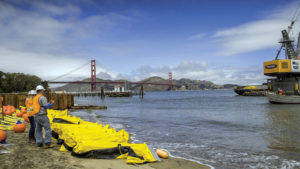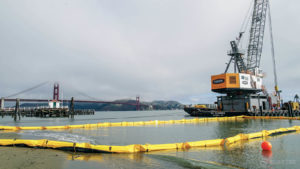Geosynthetics and marine construction near Golden Gate Bridge

Introduction
Marine construction projects often materialize with different sets of construction obstacles. In addition to the challenge of building stable structures in and under water, the environmental impact of construction must be limited.
Creative and inventive methods for mitigating environmental contamination range from artificial habitat creation to coral relocation at construction sites. The use of geosynthetic materials has proven to be one of the most cost-effective and efficient methods for limiting environmental contamination during marine construction.
A high-profile marine construction project completed for the California Department of Transportation (Caltrans) near San Francisco’s fabled Golden Gate Bridge during autumn 2015 required some special environmental considerations of its own. The Crissy Field Drainage Improvement Project was undertaken to alleviate flooding problems upstream in the Crissy Field and Mason Street areas of San Francisco. The stormwater drainage outfall pipe near the Golden Gate Bridge needed to be extended and widened to prevent blockage from sand and other sediment buildup from stormwater drainage.
The buildup of sand from tidal activity and weather events regularly buried the pipe, necessitating frequent excavation. The project aimed to increase drainage capacity to accommodate stormwater runoff from the Presidio Parkway improvement and was designed to take into account a 50-year projected sea level rise of 22 inches and beach accretion levels resulting from that rise.
A geosynthetic solution
Home to several different species of fish, including green sturgeon, steelhead trout, salmon, and smelt, the San Francisco Bay is a sensitive marine habitat that could have been negatively affected by construction activity.
The Crissy Beach area habitat consists of natural northern foredunes—coastal dunes that host native beach vegetation, including sand-verbena, beach strawberry, and beach primrose. This habitat is important for the snowy plover, which rests and forages in the foredune habitat from August through April.
The work had the potential to disrupt not only marine wildlife but their habitats as well. To protect the underwater environment during the project, a turbidity curtain was installed. The curtain minimized the impact of construction by reducing silt flow from dredging and construction activity.
“Floating fabric turbidity curtains have a minimal effect on the environment,” said Linda Henning, marketing director at curtain manufacturer, Elastec. “This was of concern due to the National Park Service’s jurisdiction of this project.”

The turbidity curtain was specifically designed for use in demanding waters, including the tidal area of the Crissy Field drainage project in San Francisco Bay near the Golden Gate Bridge. The curtain is able to control the migration of silt and turbid water in the construction zone. By intercepting debris and slowing the movement of rough water, it helps keep marine wildlife and habitat safe and intact.
The production for this project consisted of a PVC frame and a geotextile filter fabric for the curtain itself. Henning noted that the PVC provided strength and the fabric created a skirt.
The geotextile was a woven fabric with high-tenacity monofilament polypropylene yarn. The geotextile is inert to biological degradation, resists naturally encountered chemicals, and is designed for stability to ensure that the yarns retain their relative position.
The geotextile for this project was specifically designed for engineered filtration. It resists clogging while maintaining flow rates in tidal conditions and has a high survivability rating in aggressive installation and loading conditions. The durable 34-mil fabric has a tear strength of 150/165 pounds, a tensile strength of 3,000 pounds per foot, and is manufactured with highly UV-stabilized monofilament and multifilament fibers to provide uniform opening size while maintaining predictable long-term flow rates.
These design specifications made it an effective solution for the Caltrans project. Five hundred feet of the 8-ft-tall skirt curtain was configured in a U shape to encompass the work site.
The curtain is designed to both float and be anchored in position. A flotation tube is sewn into a sleeve at the top of the curtain, fastened in sections with marine-grade aluminum universal connectors. A cable runs below the flotation tube along the length of the curtain, connected every 50ft with eyebolt anchors. The curtain sections are laced together through grommets on both ends of the seam. The bottom of the curtain is tensioned with a ballast chain sewn into the bottom sleeve of the curtain, which also adds weight and stability to the geotextile.
Protecting the environment
The Crissy Field Drainage Improvement Project took place in a National Park Service jurisdiction, making it a particularly challenging undertaking. The potential environmental impact was of concern to the Park Service, the local media, and the local population.
“If any plumes of sediment escaped the work area or any marine life would have been harmed, the project would have been shut down,” said Henning. The turbidity curtain barrier assisted the construction and installation work with minimal environmental impact.
According to Henning, the use of a Type III curtain is required in tidal construction areas. “Our screen offers support cables on both sides of the curtain to support it in tidal flow,” she said. “With the wind and waves in the San Francisco area, we needed to use a heavy-duty turbidity curtain that could withstand the possible conditions.”
In addition to reducing the movement of sediment in the bay, the turbidity curtain, working in tandem with an air-bubble system, helped to reduce noise pollution in the marine environment.
The turbidity curtain made environmental mitigation possible before the construction project rather than after. Mitigation performed after a project is often much more expensive than preventative techniques and produces a questionable return of ecosystem services.
As environmental conditions become more fragile and demanding, geosynthetic solutions such as state-of-the-art turbidity barrier curtains, can play an increasingly important role in the interactions with environmental surroundings. Best practices in underwater construction zones will likely continue to incorporate geosynthetics to minimize impacts to marine and tidal habitats.
Jake Kulju is a Minneapolis-based freelance writer.
Turbidity barriers, also known as turbidity curtains, are designed to restrict sediment-laden water from storm drains and runoff in construction sites by keeping sediment contained in a limited area, allowing it to settle before spreading to surrounding waters.
They can be designed to float in place or be staked. Floating turbidity curtains offer more options, especially for large construction areas in tidal waters. Floating curtains typically use a top flotation boom and a bottom steel chain. Top and bottom are sealed inside a fabric hem; curtain sections can be attached through grommets with ropes or nuts and bolts. Filter fabric is inserted between the top and bottom of the curtain, retaining silt and sediment while allowing water to pass through.
 TEXTILES.ORG
TEXTILES.ORG


